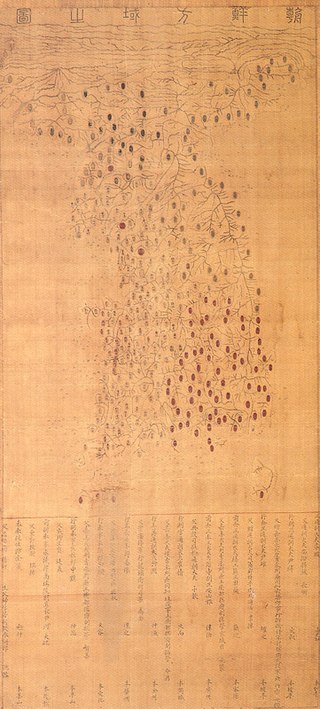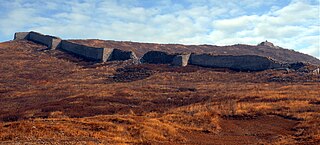Korea's provinces have been the primary administrative division of Korea since the mid Goryeo (Koryo) dynasty in the early 11th century, and were preceded by provincial-level divisions dating back to Unified Silla and Balhae during the Northern and Southern States period, in the 7th century.

Goguryeo also later known as Goryeo, was a Korean kingdom located in the northern and central parts of the Korean Peninsula and the southern and central parts of modern day Northeast China. At its peak of power, Goguryeo controlled most of the Korean Peninsula, large parts of Manchuria and parts of eastern Mongolia and Inner Mongolia as well as Russia.

Balhae, also rendered as Bohai, was a multi-ethnic kingdom established in 698 by Dae Joyeong and originally known as the Kingdom of Jin until 713 when its name was changed to Balhae. At its greatest extent it corresponded to what is today Northeast China, the northern half of the Korean Peninsula and the southeastern Russian Far East.

Goryeo was a Korean state founded in 918, during a time of national division called the Later Three Kingdoms period, that unified and ruled the Korean Peninsula until 1392. Goryeo achieved what has been called a "true national unification" by Korean historians as it not only unified the Later Three Kingdoms but also incorporated much of the ruling class of the northern kingdom of Balhae, who had origins in Goguryeo of the earlier Three Kingdoms of Korea. The name "Korea" is derived from the name of Goryeo, also romanized as Koryŏ, which was first used in the early 5th century by Goguryeo. According to Korean historians, it was during the Goryeo period that the individual identities of Goguryeo, Baekje and Silla were successfully merged into a single entity that became the basis of the modern-day Korean identity. Goryeo was the successor state to Later Goguryeo and Goguryeo.

The Three Kingdoms of Korea or Samhan competed for hegemony over the Korean Peninsula during the ancient period of Korean history. During the Three Kingdoms period, many states and statelets consolidated until, after Buyeo was annexed in 494 and Gaya was annexed in 562, only three remained on the Korean Peninsula: Goguryeo, Baekje and Silla. The "Korean Three Kingdoms" contributed to what would become Korea; and the Goguryeo, Baekje and Silla peoples became what we know as the Korean people.

South Gyeongsang Province is a province in the southeast of South Korea. The provincial capital is at Changwon. It is adjacent to the major metropolitan center and port of Busan. The UNESCO World Heritage Site Haeinsa, a Buddhist temple that houses the Tripitaka Koreana and tourist attraction, is located in this province. Automobile and petrochemical factories are largely concentrated along the southern part of the province, extending from Ulsan through Busan, Changwon, and Jinju.

Jeolla Province was one of the historical Eight Provinces of Korea during the Kingdom of Joseon in southwestern Korea. It consisted of the modern South Korean provinces of North Jeolla, South Jeolla and Gwangju Metropolitan City as well as Jeju Province. The provincial capital was Jeonju, the current capital of North Jeolla. The entire inland region was called Honam, which is still commonly used today.

During most of the Joseon Dynasty, Korea was divided into eight provinces. The eight provinces' boundaries remained unchanged for about 480 years from 1413 to 1895, and formed a geographic paradigm that is still reflected today in the Korean Peninsula's administrative divisions, dialects, and regional distinctions. The names of all eight provinces are still preserved today, in one form or another. These eight historical provinces form both North and South Korea, and are not to be confused with the provinces that make up South Korea or North Korea.

The Liaodong or Liaotung Peninsula is a peninsula in southern Liaoning province in Northeast China, and makes up the southwestern coastal half of the Liaodong region. It is located between the mouths of the Daliao River in the west and the Yalu River in the east, and encompasses the territories of the whole sub-provincial city of Dalian and parts of prefectural cities of Yingkou, Anshan and Dandong.
The Protectorate-General to Pacify the East was an administrative division of the Chinese Tang dynasty in Manchuria and the northern part of the Korean Peninsula. It was established after the Tang dynasty defeated Goguryeo and annexed its territories. In the place of Baekje and Goguryeo, the Tang dynasty created the Protectorate General to Pacify the East and the Ungjin Commandery. A proposal to set up the Great Commandery of Gyerim by the Emperor Gaozong of Tang to King Munmu of Silla was refused.
Seongjong of Goryeo (r. 981–997) was the sixth ruler of the medieval Korean kingdom of Goryeo.

The Cheolli Jangseong or Great Wall of Korea may refer to either of two massive fortifications built between medieval Korea and the Chinese to the west and other tribes to the north. The first is a 7th-century network of military garrisons built by Goguryeo, one of the Three Kingdoms of Korea. These are now located in Northeast China. The second is an 11th-century wall built by Korea's Goryeo dynasty, now located in North Korea.

Hokiang, was a province in Northeast China, which was established in 1945. It was c.52,300 sq mi (135,500 km²) in size and the provincial capital was Jiamusi.

The military history of Goguryeo involves wars with other Korean kingdoms, Chinese dynasties, nomadic states and tribes, and Wa Japan. Goguryeo was a highly militaristic state; it was a powerful empire and one of the great powers in East Asia, until it was defeated by a Silla–Tang alliance in 668 after prolonged exhaustion and internal strife caused by the death of Yeon Gaesomun.

Mishan is a county-level city in the southeast of Heilongjiang Province, China, bordering Russia's Primorsky Krai to the south and southeast. It is under the jurisdiction of the prefecture-level city of Jixi.

Tongjiang is a city of 160,000 in eastern Heilongjiang province, People's Republic of China, located at the confluence and on the right banks of the Songhua and Amur Rivers, the latter which marks the border with Russia. Administratively, it is a county-level city of Jiamusi.

Hwando is a mountain fortress of the ancient Korean kingdom of Goguryeo, built to protect Goguryeo's second capital, Gungnae. It is located in present-day Ji'an city of the province of Jilin, China.

The history of Sino-Korean relations dates back to prehistoric times.

Yanzhou Village is a small settlement in Dengta Prefecture of Liaoyang Prefecture in Liaoning Province in China. The village is the site of the ancient Goguryeo city of Baegam in Korea or Baiyan City in Chinese. The ancient city was the scene a major battle between the Tang dynasty Chinese emperor Taizong and the Goguryeo in 645 AD.

The Military of the Goryeo Dynasty was the primary military force of the Goryeo Dynasty. During the Later Three Kingdoms Period, Wang Geom overthrew the Taebong ruler, Gung Ye, and renamed it Goryeo after the Goguryeo Dynasty. He led the kingdom's armies and navies against Silla and Later Baekje and unified the peninsula. Goryeo was able to mobilize sizable military might during times of war.















